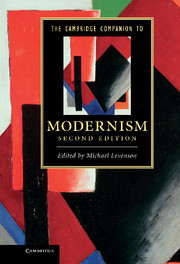Book contents
- Frontmatter
- Introduction
- 1 The metaphysics of Modernism
- 2 The cultural economy of Modernism
- 3 The Modernist novel
- 4 Modern poetry
- 5 Modernism in drama
- 6 Modernism and the politics of culture
- 7 Modernism and religion
- 8 Modernism and mass culture
- 9 Modernism and gender
- 10 Musical motives in Modernism
- 11 Modernism and the visual arts
- 12 Modernism and film
- 13 Modernism and colonialism
- Further reading
- Index
7 - Modernism and religion
Published online by Cambridge University Press: 28 September 2011
- Frontmatter
- Introduction
- 1 The metaphysics of Modernism
- 2 The cultural economy of Modernism
- 3 The Modernist novel
- 4 Modern poetry
- 5 Modernism in drama
- 6 Modernism and the politics of culture
- 7 Modernism and religion
- 8 Modernism and mass culture
- 9 Modernism and gender
- 10 Musical motives in Modernism
- 11 Modernism and the visual arts
- 12 Modernism and film
- 13 Modernism and colonialism
- Further reading
- Index
Summary
In February, 1928, soon after T. S. Eliot had converted to Anglo-Catholicism, Virginia Woolf wrote to her sister Vanessa Bell:
Then I have had a most shameful and distressing interview with poor dear Tom Eliot, who may be called dead to us all from this day forward. He has become an Anglo-Catholic, believes in God and immortality, and goes to church. I was really shocked. A corpse would seem to me more credible than he is. I mean, there's something obscene in a living person sitting by the fire and believing in God.
Seeing Woolf's unmistakable personal hostility towards God, certain critics have understood her work as distinctively atheist. Woolf's revulsion against Eliot's religious beliefs may seem part and parcel of her rejection of patriarchal authority: what better representative of patriarchy than God the Father? Yet, Woolf's putative atheism is complicated by her relation to her own father, Leslie Stephen, the most famous agnostic in Victorian England, against whom much of her work rebels.
- Type
- Chapter
- Information
- The Cambridge Companion to Modernism , pp. 178 - 196Publisher: Cambridge University PressPrint publication year: 2011
- 3
- Cited by

